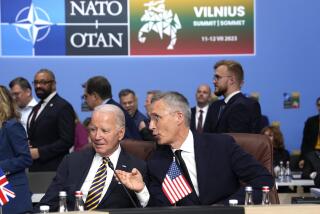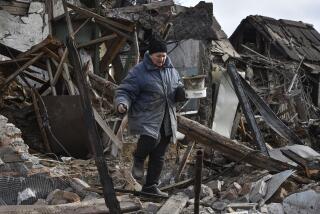NATO Continues Attacks, Vows to Lift Serb Threat : Bosnia: Alliance warplanes pound rebel positions in hopes of finally ending assaults on Sarajevo and other ‘safe areas.’ West also seeks to restore its credibility.
ZAGREB, Croatia — In a new phase in the Balkan war, wave after wave of U.S. and European warplanes bombed Bosnian Serb missile batteries, air-defense radar units and command centers across Bosnia-Herzegovina on Wednesday in the largest military operation in NATO history.
As the beleaguered residents of Sarajevo cheered allied aircraft buzzing overhead, NATO and U.N. officials vowed to continue punishing the nationalist Serbs until they no longer threaten the Bosnian capital and other civilian enclaves.
“The world has finally done what it should have done a long, long time ago,” Bosnian President Alija Izetbegovic said.
With the massive show of force, the West, after nearly 3 1/2 years of impotent humiliation in the former Yugoslav republic, is hoping to restore its eroded credibility while forcing the Bosnian Serbs to sue for peace.
Among developments Wednesday:
* Lt. Gen. Bernard Janvier, commander of U.N. troops in the Balkans, said damage from air strikes and artillery attacks was considerable, although full assessments were still being made. Targets reported hit included Lukavica, the Serbs’ principal military barracks just south of Sarajevo, and a key munitions factory in Vogosca, north of the Bosnian capital.
* While allied officials boasted of the mission’s success, one French Mirage fighter was apparently shot down by rebel Serbian gunners. The fate of the two-man crew was unknown. And three Spaniards who were members of a European Union monitoring team, as well as two of their employees, reportedly were killed when their armored vehicle was struck by shells in a Serb-held suburb of Sarajevo.
* Bosnian Serb leaders reacted defiantly, but several hours into the air raids, Bosnian Serb army commander Gen. Ratko Mladic contacted U.N. officials to seek a cease-fire, Western sources said. Mladic offered to withdraw big guns from around Sarajevo, but U.N. officials laid down more conditions before they would agree to call off their jets, the sources said.
* Arriving in Belgrade, the Serbian capital, a U.S. delegation pressed ahead with a peace initiative, hoping Wednesday’s attacks will strengthen, not derail, the effort. There were indications that the Serbs had agreed among themselves on new responses to the latest international proposals.
* While President Clinton said he hoped the military action had taught the Bosnian Serbs that their quest for a Greater Serbia had reached its end and U.N. Secretary General Boutros Boutros-Ghali said the mission has his full support, Russian President Boris N. Yeltsin condemned the bombardment, contending it would not help bring peace to the Balkans.
The Assault
On Wednesday, United Nations and North Atlantic Treaty Organization forces continued attacks against Bosnian Serb military targets, pummeling strategic sites such as command centers, ammunition dumps and individual tanks and artillery.
Officials said successive waves of NATO warplanes from air bases in nearby Italy and the U.S. aircraft carrier Theodore Roosevelt flew repeated missions near Sarajevo and other cities such as Tuzla and Mostar.
The allied air armada included Air Force F-15E and F-16C fighters, Navy and Marine Corps F/A-18 attack aircraft, and warplanes from British, French, Dutch and other allied air forces.
Both NATO and U.S. officials refused to disclose many details of the assault and its effects, contending that the information might be of use to the Bosnian Serbs.
There were mixed reports about the extent of the damage from Wednesday’s raids.
While NATO officials proclaimed the missions largely successful, Pentagon officials were cautious.
There was no immediate indication of how long the allies would continue their attacks, but a senior U.S. military official said NATO was prepared to sustain the bombing for at least two more days.
In the first allied casualty of the week’s operations, a French Mirage 2000 fighter-bomber--one of the more than 60 warplanes involved in the 200-plus sorties flown against targets in Bosnia--was shot down by antiaircraft missiles near the Bosnian Serbs’ self-styled capital, Pale.
Initial indications were that the two crew members ejected safely, and French Defense Minister Charles Millon vowed to do everything in his power to rescue them.
NATO immediately launched search-and-rescue teams.
Pentagon officials also confirmed that they have ordered another dozen or so warplanes to fly from bases in the United States and Europe to the region around Bosnia to augment existing allied forces.
On Wednesday, British, French and Dutch artillery joined the assault around Sarajevo, firing about 600 rounds against Bosnian Serb gun emplacements and ammunition dumps.
At the United Nations, Boutros-Ghali reported that French Lt. Gen. Janvier has demanded that Mladic, the Bosnian Serb commander, withdraw all his heavy weapons beyond a 12 1/2-mile exclusion zone that surrounds Sarajevo.
Although he stated that the United Nations was not at war with the Bosnian Serbs, the U.N. secretary general warned that “if they persist in their unacceptable attacks upon civilians, the United Nations will continue to support NATO’s use of air power.”
Late Wednesday, Mladic rejected the U.N. demands, according to reports from Pale.
Allied leaders launched their military assault in reprisal for the lethal shelling Monday of Sarajevo that killed at least 37 people, most civilians, and injured 80 others.
U.N. and U.S. officials blamed the marketplace attack on the Bosnian Serbs. It was one of a series of incidents that has drawn condemnation from the world community; the rebel Serbs also have been sharply criticized for overrunning U.N.-designated “safe areas” and allegedly committing atrocities there, and for kidnaping and using international peacekeepers as hostages.
The Peace Trail
Even as Bosnia was being bombed, the United States pushed ahead with a peace initiative for the beleaguered area.
Assistant Secretary of State Richard Holbrooke traveled to Belgrade with the latest U.S. peace proposal and held a daylong meeting with Serbian President Slobodan Milosevic, the regional powerbroker who may hold the key to ending the war.
“President Clinton has sent us here on a mission of peace at a moment of war,” Holbrooke said, adding that the talks had suddenly become more urgent.
U.S. officials said they were encouraged that Milosevic agreed to the meeting, despite the new military effort against his Bosnian Serb allies.
U.S. and allied officials said they hoped Holbrooke’s hand will be strengthened by the unprecedented display of might.
“This is supportive of the diplomatic initiative because it shows, contrary to what the Serbs have believed, that we can inflict pain,” an official from a NATO country said in Zagreb.
The U.S. diplomatic initiative offers the lifting of economic sanctions, which were imposed against the rump Yugoslavia for its role in fomenting the war, if Milosevic agrees to recognize Bosnia and Croatia. It also allows the Bosnian Serbs to keep nearly half of Bosnia, most of the territory they seized after rebelling against Bosnia’s decision to declare its independence in 1992.
Defiant Serbs
Bosnian Serb leader Radovan Karadzic said the bombings represented a “moral disaster” for the West that created a “precedent that could endanger world peace and trigger World War III.”
“How can they explain to their people that they are taking sides in a civil war?” he asked. Karadzic was in Belgrade, where he hoped to join the meeting with Holbrooke. U.S. officials have refused to negotiate with Karadzic, preferring to recognize only Milosevic as representing the Serb side.
Bosnian Serb radio filled its programs with coverage of the allied attacks, which the radio said hit primarily civilian targets, and with purported interviews of residents of Pale, who in unison vowed to fight on.
In Washington, the Clinton Administration said it hoped the bombing has taught the Bosnian Serbs that “their quest for a Greater Serbia is over.”
“It is finished,” State Department spokesman Nicholas Burns told reporters. “The tide of the war has turned against them. . . . They cannot seek a military solution to this conflict; they have to seek a political solution.”
Senate Majority Leader Bob Dole, the leading candidate for the Republican presidential nomination, said in a statement while campaigning in Wolfeboro, N.H., that he might postpone a Senate vote on whether to override the President’s veto of legislation lifting the arms embargo on Bosnia.
Burns insisted that the bombing reflected a key element in the new dynamic of Bosnia--”the cohesiveness of the Western countries.” He said that, after the “terrible tragedy” of the fall of the U.N.-designated safe areas of Srebrenica and Zepa, Secretary of State Warren Christopher had “worked very hard to produce a positive outcome whereby the West was united in one important way--that . . . further attacks against the safe areas . . . would be met by substantial and decisive military force. And that is what we have seen over the last 12 hours.”
Times staff writers Stanley Meisler and Art Pine in Washington contributed to this report, as did Times special correspondent Laura Silber in Belgrade.
(BEGIN TEXT OF INFOBOX / INFOGRAPHIC)
Seeking Peace by Force
Wave after wave of NATO warplanes attacked Serbian targets early Wednesday in retaliation for the rebel artillery attack on a Sarajevo market that killed 37 people. Bosnian and Western leaders are hoping the NATO strikes will force the rebel Serb government to agree to peace.
THE ATTACK
FIRST WAVE: More than 60 NATO warplanes, including 50 U.S. aircraft, bomb Serbian air-defense radar, communication sites, ammunition depots and command posts.
SECOND WAVE: Bombardment continues of similar targets throughout Bosnia.
THIRD WAVE: U.S. F-16 aircraft bombs Bosnian Serb military targets near Sarajevo.
FOURTH WAVE: Two F-16s set fire to a Bosnian Serb ammunition dump in the Sarajevo suburb of Lukavica.
FIFTH WAVE: The Bosnian Serb headquarters in Pale, 10 miles southeast of Sarajevo, is hit.
Artillery Fire: Between the nighttime and daytime air assaults, the U.N. multinational rapid-reaction force stationed on Mt. Igman, southwest of Sarajevo, pounded Serbian positions around the city.
CASUALTIES
* A French Mirage 2000 fighter was shot down near Pale. NATO officials believe the crew of the downed aircraft was able to safely eject. Two parachutes were seen floating down.
* Rebel Serb media reported that at least five European Union observers were killed by the air strikes.
WHAT’S NEXT
No timetable has been set for ending the air strikes and artillery bombardment of Serbian targets. More strikes could be forthcoming if the Serbs fight back.
****
“Our objective is to reduce the threat to the Sarajevo safe area and to deter further attacks there or any other safe area . . . [And] if the Bosnia Serbs are continuing to launch a challenge, we will continue and even enhance our military activities.”
--Willy Claes, NATO chief
Source: Times wire reports
(BEGIN TEXT OF INFOBOX / INFOGRAPHIC)
REACTION TO THE U.N. AND NATO ATTACKS ON BOSNIAN SERBS:
“The Bosnian Serbs, especially after the events of the last 12 hours, ought to have concluded that there is no military victory in sight for them, the tide of the war has turned against them, their dream of a greater Serbia is no more, it’s time to face the responsibility of peace.”
--Nicholas Burns, State Department spokesman
****
“I strongly support this operation.”
--President Clinton
****
“Boris Yeltsin denounces all acts of violence on the territory of the former Yugoslavia, both the Serb shelling of peaceful areas and NATO’s cruel bombardment and artillery strikes on Serb positions.”
--Sergei K. Medvedev, spokesman for Russian President Boris N. Yeltsin.
****
“The world has finally done what it should have done a long, long time ago. . . . We are seeing, not the beginning of a war but the start of peace.”
--Alija Izetbegovic, Bosnian President
****
“I feel good, oh yes! I really feel good, probably for the first time in this war.”
--Musrata Sabic, Sarajevo resident
(BEGIN TEXT OF INFOBOX / INFOGRAPHIC)
AIR SUPERIORITY OVER BOSNIA
The NATO warplanes involved in the bombing of Serbian targets in Bosnia are part of the Western alliance’s “Operation Deny Flight” set up in April 1993 to enforce a U.N. “no-fly” zone over Bosnia. Here are the countries and their contribution to the alliance.
FRANCE
4 Mirage F-1CR
5 Mirage 2000C
5 Jaguar ground attack aircraft
6 Super Etendard fighter-bombers
3 Mirage 2000KD ground attack aircraft
3 F-ICT
1 C-135 air-to-air refueling aircraft
1 E-3F airborne early warning aircraft at Avord
ITALY
8 PA-200 Tornados
NETHERLANDS
4 F-16A fighter aircraft
5 F-16A ground attack aircraft
3 F-16R reconnaissance aircraft
SPAIN
1 CASA 212 support aircraft
8 EF-18A fighter aircraft
2 KC-130 air-to-air refueling aircraft
TURKEY
8 F-16C fighter aircraft
BRITAIN
6 F-3 Tornado fighter aircraft
6 GR-7 Harrier aircraft
2 GR-7 Harrier reconnaissance aircraft
6 Sea Harriers
2 K-1 Tristar L-1011 air-to-air refueling aircraft
UNITED STATES
8 USAF F-15E
12 USMC F-18D
12 USAF F-16C
8 USAF F-16C/D
8 USAF O/A-10 ground attack aircraft
3 USAF EC-130 Airborne Battlefield Command and Control Center aircraft
3 USAF EC-130 electronic warfare aircraft
2 USAF AC-130 gunships
10 USAF KC-135 air-to-air refueling aircraft
6 USAF EF-111A electronic warfare aircraft
6 USN EA-6B electronic warfare aircraft
NATO Airborne Early Warning Force aircraft
8 E-3A aircraft
2 E-3D aircraft
More to Read
Sign up for Essential California
The most important California stories and recommendations in your inbox every morning.
You may occasionally receive promotional content from the Los Angeles Times.











